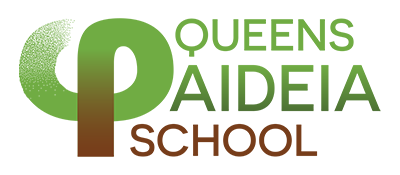Queens Paideia’s curricular goal has always been to impart to students the tools for successfully understanding and interacting with the world around them. A few years in, we began our belief systems program, through which students learned how beliefs are formed and sustained over time. This pertained most obviously to religion, but QPS’s conceptual framework was also applicable to other areas infused by beliefs, such as racism/othering, food, at-times science, and a person’s media preferences and habits. We taught them all, in age-appropriate formats, and when our students went on to learn these same things in high school, it was familiar turf.
To teach media literacy, we needed to be current in our research and dynamic in our approach. The former was not easy; there were few media resources available that were not already outdated. Things were changing fast. But we could also change fast. In 2014, we created a curriculum about the in-progress shift away from television, movie theaters, and radio programs, to the online world of games, shopping, social media, and advertising. Within two years, those learning plans were obsolete, but these subjects still require treatment at any school that is serious about preparing its students for their future—at the very least, helping them be aware of and guarded against cyber bullying, online game addiction and its consequences, and the feelings of alienation that arise from watching everyone Iive their best life on Instagram.
Then Came 2016
Prior to 2106, we did not anticipate–no one did–the urgency of leaning heavier on media literacy, specifically fake news, and what that would mean to our curriculum going forward. It’s now common parlance to urge parents and schools to educate children on how to discern reliable sources from fake and illegitimate ones. In the almost-three years since this issue first seized the world’s sensibilities, there has been a lot of talk but not enough action to directly help children understand what is their foreseeable future.
There are now more resources available for teaching media literacy, but the crucial issue of how best to deliver core questions, relevant skills, and necessary practice is always the one that determines how and when it happens. At QPS so much of our curriculum was already integrated and focused on thinking skills and heuristics (questioning), both of which are integral to navigating media in its myriad forms. So, for sure it was about adding in more but it was also about recasting what we were already doing.
Anticipating, and Acting
In social studies, students delve into satire vs. non-satire, memes and infographics as potential carriers of misinformation, sources of fake news (e.g., foreign gov’t sewing division), balanced news vs. biased media (comparing the same news story across multiple platforms), how different so-called mainstream news sources are ranked in terms of their bias quotient, and so forth. They do the same in science, in part as a way of learning about confirmation bias.
According to Learning Manager Jonathan Acampora, “At this point, I’d say one-third of QPS’s ELA curriculum is tied to media literacy for fourth grade and up. It fits in well with our ongoing discussions about point-of-view, reliable and unreliable narrators, and the power of narrative.” As part of Acampora’s instruction in English Language Arts, students study advertising, reliable vs. unreliable news sources, and how to identify author bias. In one class, they zoomed in on strategies for determining an online news article’s veracity.
It turns out that media literacy and reading novels, poetry, and learning literary analysis are complementary, compatible, and related. At heart, they are about stories, and figuring out truth from fantasy, fraud, and willful deceit.
